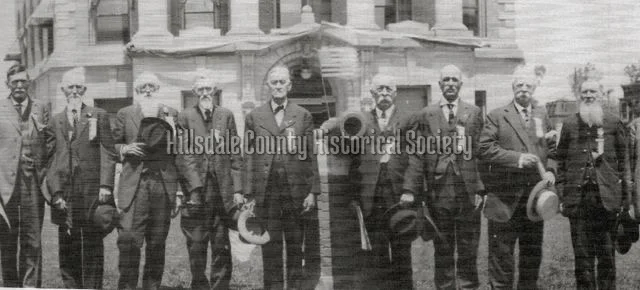The Grand Army of the Republic
After the Civil War, veterans maintained a connection to each other through various organizations. As with all wars, no one else understood the horror of what they'd been through; their shared experiences in the war led to a natural fellowship. The Grand Army of the Republic (G.A.R.) was the best known of the organizations of veterans. Linking men initially through their experience of the war, the G.A.R. became among the first organized advocacy groups in American politics. Founded in 1866 in Decatur, Illinois, it was only dissolved when its last member died in 1956.
The G.A.R. supported voting rights for black veterans and lobbied the U.S. Congress to establish veterans' pensions. It became a powerful wing of the Republican Party until that political party's commitment to reform in the South faltered. Over 400,000 men belonged to the G.A.R. in 1890, a year when many Civil War commemorative ceremonies were held.
In 1879 the G.A.R. Post, No. 6 was organized in Hillsdale. It was named the C.J. Dickerson Post after General Christopher J. Dickerson, who had been gallant in the war and much admired in civilian life. A wonderful picture of the surviving G.A.R. members hangs both in the Will Carleton Poorhouse and the Friends of the Mitchell Research Center. In the early teens of the 20th century, white haired and white bearded, they still stand tall and proud in front of City Hall
JoAnne P. Miller
At a meeting held in the Hillsdale County Courthouse on the evening of Oct. 12, 1866, local veterans of the Civil War met for the purpose of establishing a local company of the "Boys in Blue."
Members of the Old Fourth Michigan and Company G of the Second Michigan Cavalry gathered for a reunion and had this picture taken in from of the Henry Waldron home (which today is the Elks' Club).
For a number of years the G.A.R. met in an upstairs room on the Waldron Block. They later moved across the street and south, still on Howell Street. The G.A.R. continued to exist in Hillsdale until the death of loyal member, George Slayton in 1939.
Members gathered with their spouses surrounding the Civil War cannon. The cannon remained there until World War II, when it was "scrapped" for the "war effort."
Carol A. Lackey




